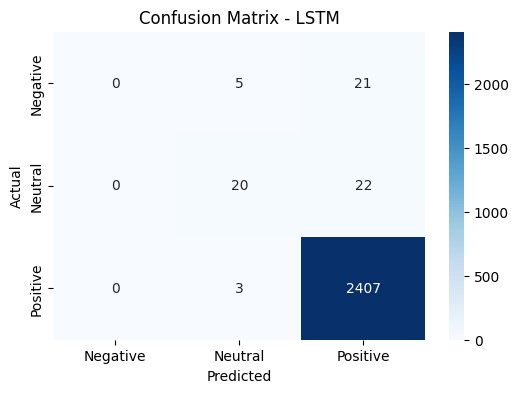Comparative Performance of Deep Learning Approaches for Sentiment Analysis on Pakistani Dramas and Movies Reviews
Keywords:
Sentiment Analysis, Deep Learning, Pakistani Dramas, Movie Reviews, Convolutional Neural Network (CNN), Long Short-Term Memory (LSTM), Bi-LSTM, GRU, Recurrent Neural Network (RNN), Text Preprocessing, Accuracy Comparison, Multilingual DataAbstract
Sentiment analysis plays an important role in natural language processing, helping to understand public opinions shared through text. This study focuses on the challenge of analyzing sentiments in reviews of Pakistani dramas and movies, where mixed languages, informal expressions, and noisy data make accurate classification difficult. To solve this problem, several deep learning models were used and tested, including Long Short-Term Memory (LSTM), Gated Recurrent Unit (GRU), Bidirectional LSTM (Bi-LSTM), Recurrent Neural Network (RNN), and Convolutional Neural Network (CNN). A detailed dataset of 12,000 user reviews was collected from platforms like IMDb and YouTube. The data was cleaned and prepared through steps such as tokenization, removing unnecessary columns, normalizing, and using sentiment scoring and word embedding for feature extraction. These models were trained and tested, with their performance evaluated using accuracy, precision, recall, and F1-score. Among all, the CNN model performed the best, achieving 98.71% accuracy and a 98.49% F1-score. The Bi-LSTM model was close behind, with 98.59% accuracy and a 98.47% F1-score. In the future, the research will explore the use of advanced transformer-based models like BERT and GPT for multilingual sentiment analysis. It will also aim to build real-time sentiment classification systems. Moreover, creating sentiment lexicons for regional languages and using hybrid deep learning methods are suggested to further improve accuracy and generalization.
References
Amna Malik, “Introduction, Growth and Future of Web Series in Pakistan: An Exploratory Study,” Pakistan Soc. Sci. Rev., vol. 4, no. 2, pp. 1085–1095, 2020, doi: 10.35484/pssr.2020(4-II)86.
M. K. Shivani Awasthi, Inderpreet Kaur, “A Comprehensive Analysis of the Current Methods, Challenges and Innovations in Sentiment Analysis,” J. Inf. Syst. Eng. Manag., vol. 10, no. 23, 2025, doi: https://doi.org/10.52783/jisem.v10i23s.3712.
P. V. Roopam Srivastava, P. K. Bharti, “Comparative Analysis of Lexicon and Machine Learning Approach for Sentiment Analysis,” Int. J. Adv. Comput. Sci. Appl., vol. 13, no. 3, 2022, [Online]. Available: https://thesai.org/Publications/ViewPaper?Volume=13&Issue=3&Code=IJACSA&SerialNo=12
H. S. A. Sani Muhammad, Ahmad Abubakar, “Sentiment Analysis of Hausa Language Tweet Using Machine Learning Approach,” J. Res. Appl. Math., vol. 8, no. 9, pp. 07–16, 2022, [Online]. Available: https://www.questjournals.org/jram/papers/v8-i9/08090716.pdf
M. B. Mustajeeb ur Rehman, “Sentiment Analysis on Disputed Territory Discrepancies Using Machine Learning-based Text Mining Approach,” VFAST Trans. Softw. Eng., vol. 11, no. 2, pp. 17–25, 2023, doi: https://doi.org/10.21015/vtse.v11i2.1486.
N. A. Lal Khan, Ammar Amjad, Hsien-Tsung Chang, “Multi-class sentiment analysis of urdu text using multilingual BERT,” Sci. Rep., vol. 12, no. 1, 2022, [Online]. Available: 10.1038/s41598-022-09381-9
M. Ali, S. Asghar, A. Mrhari, A. Ullah, U. U. Aleem, and R. Hassnae, “A Hybrid CNN-BiLSTM-Based Approach for Roman Urdu Sentiment Analysis Using Enhanced Roman Urdu Corpus,” https://doi.org/10.1142/S2717554524500097, vol. 34, no. 03n04, Jan. 2025, doi: 10.1142/S2717554524500097.
I. U. Khan et al., “A Review of Urdu Sentiment Analysis with Multilingual Perspective: A Case of Urdu and Roman Urdu Language,” Comput. 2022, Vol. 11, Page 3, vol. 11, no. 1, p. 3, Dec. 2021, doi: 10.3390/COMPUTERS11010003.
A. K. Durairaj and A. Chinnalagu, “Sentiment Analysis on Mixed-Languages Customer Reviews: A Hybrid Deep Learning Approach,” Proc. 2021 10th Int. Conf. Syst. Model. Adv. Res. Trends, SMART 2021, pp. 551–557, 2021, doi: 10.1109/SMART52563.2021.9676277.
D. D. Londhe, A. Kumari, and M. Emmanuel, “Challenges in Multilingual and Mixed Script Sentiment Analysis,” 2021 6th Int. Conf. Converg. Technol. I2CT 2021, Apr. 2021, doi: 10.1109/I2CT51068.2021.9418087.
S. K. Kruttika Jain, “A Comparative Study of Machine Learning and Deep Learning Techniques for Sentiment Analysis,” Conf. 2018 7th Int. Conf. Reliab. Infocom Technol. Optim. (Trends Futur. Dir., 2018, doi: 10.1109/ICRITO.2018.8748793.

Downloads
Published
How to Cite
Issue
Section
License
Copyright (c) 2025 50sea

This work is licensed under a Creative Commons Attribution 4.0 International License.




















